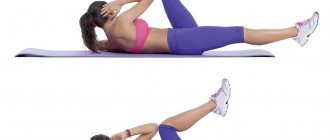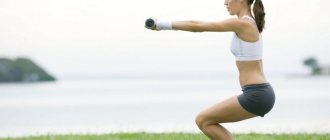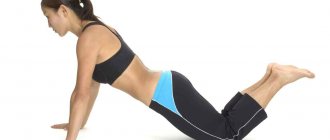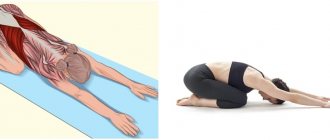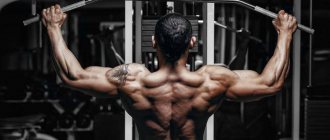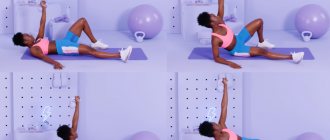Abdominal exercises are done at the end of each workout. But not all, and not always. In bodybuilding, incline crunches are a necessary part of the plan for the beginner and intermediate athlete. Those who have fairly hypertrophied abs usually only “pump up” them with simpler exercises. In other strength disciplines, incline crunches are also used. Strength workers do it to compensate for the deflection in the spine that occurs when squats. Athletes of other disciplines - just to pump up their abs. This popular movement has quite a few subtleties. After all, most athletes do it incorrectly, but solely through the quadriceps and body jerks. But once you learn how to do the twist correctly, you will feel the difference.
Execution technique
Initial position
- Secure your knees to the bolsters of a crunch bench;
- Press your buttocks against the surface of the bench;
- Tighten your stomach;
- Place your hands behind your head;
- Lean back to horizontal
Movement
- As you exhale, contract your abdominal muscles;
- Bring the lower ribs to the pelvic bones;
- Pull your stomach in even more;
- At the peak of the contraction, pause for a moment and then repeat.
Attention
- Technically, some people do a full lift rather than a crunch. They lie down on a bench and, due to the inertia and strength of the quadriceps, lift the body completely. It is not advisable to perform this movement exactly this way, because the press will no longer work in such a technique;
- There is no need to bend your lower back inward to increase the amplitude. This overloads the back and can lead to protrusions;
- Pressing your palms on the back of your head should be avoided. If the pressure is too strong, the cervical vertebrae may be displaced;
- The bench should be adjusted so that the shins do not move too far away from the pads of the machine when lowering the body down.
Recommendations
- The twist is performed by rounding the back rather than by “bringing” the shoulders toward the knees with a strong flexion at the hip joint. Round your spine and roll your shoulders forward;
- Try to follow the principle of “exhale with effort.” The peak contraction at the top point should be performed when there is almost no air in the lungs;
- Work smoothly, avoid jerking, so that the efforts to lift the body become more measured, and the insulation works
It's a PRECIOUS TRUSH, baby.
Execution options
- In a Roman chair . This machine is designed to protect the athlete's back. It is only important that it suits the athlete’s height. It is necessary to ensure that the pelvis does not come off during twisting. The athlete can perform a backbend slightly deeper than a normal crunch;
- Diagonal or cross crunches . In this version of the exercise, we reach with the opposite shoulder towards the hip or knee. This option should work the oblique muscles more. But it does not provide significant hypertrophy, so those who want to have a thin waist can also do it;
- Twisting from a lying position on a bench . This variation is reminiscent of the classic crunch while lying on the floor. A full body lift is not required here. The athlete's goal is to bring the lower ribs to the pelvic bones. You need to pull in your stomach, and gradually bring your ribs to the pelvis, and then lower yourself to the starting position;
- Weighted crunches . They help not only to build muscles, but also to work out the abs in strength mode. The abs are also pumped with weights in order to get “pronounced abs” and muscle hypertrophy.
Common Mistakes
The exercise is quite simple technically. Therefore, the mistakes made are elementary and easily corrected.
Among them:
- Fast pace of movement
This error significantly reduces efficiency.
For optimal impact on the abdominal muscles, the exercise must be performed slowly and under control , constantly keeping the abs tense.
- Excessive arching in the lower back when lowering the legs
By lowering your legs to the starting position and lifting your lower back off the bench, you overload your spine and relax your abdominal muscles.
As you move down, try to press your lower back against the surface of the bench as tightly as possible.
Raise your legs up as soon as you feel your lumbar region begin to arch.
If this happens too early and the amplitude is small, reduce the load by reducing the angle of inclination.
Anatomy of exercise - which muscles work
Target working muscle and auxiliary muscles:
- Rectus abdominis muscle
- Quadriceps, obliques, tensor fasciae lata, iliopsoas
Benefits of the exercise:
- Suitable for beginners;
- Allows you to progress and increase the load;
- Not dangerous;
- Has many modifications and options
Flaws
Those who go to an inexpensive gym will have to suffer for quite a long time if their shins are slightly larger than those of the average person. It is not convenient to train on an incline bench for those who have large hamstrings. Such people cannot always adjust a cheap small shop to suit themselves. More professional equipment takes into account the anthropometric characteristics of professional athletes. The second disadvantage is the inability to adequately perform the movement at home. They sell universal benches for the home, but they are only convenient for working out your abs, and not for performing other exercises as well.
Pros and cons of the exercise
Raising your legs while lying on your back is an exercise that has almost no downsides. Main advantages:
- High-quality work on the abs with an emphasis on the lower part.
- Improving the tone and definition of the lower part of the rectus abdominis muscle.
- Prevention of inguinal and umbilical hernias.
- Preventing protrusion and changes in the position of internal organs (mainly the large intestine).
In general, the lying leg raise is a movement that needs to be performed not only by athletes, but by all people. There is only one minus - incorrect execution, which can be solved by mastering the correct technique.
Preparation for execution
You need to set the inclination of the bench to about 30 degrees, and adjust the height of the locking rollers so that your legs are comfortable and your pelvis remains on the bench when lifting. It is necessary to practice lifting onto the bench and develop the starting position.
If the projectile swings from side to side, it is worth strengthening it by placing pancakes on both sides of the legs.
The abs are usually worked out at the end of a workout, and there is no need to warm up before them. If a person has problems with mobility in the hip joints, he should perform circular rotations of the pelvis, abduction of the hips to the side, and bends forward in a volume sufficient to warm up.
Abdominal exercises. Lifting the body.
Load progression
First you need to go through all the stages of increasing the angle of the bench. When you get to 90 degrees and a full lift with a pause at the point of contraction, this option is exhausted;
The next step is leg weights. It is better to use sand-filled fabric weights for fitness rather than holding a dumbbell between your feet;
Rubber bands are an excellent replacement for weights. A loop is made from a rubber shock absorber, put on the legs, and the athlete simultaneously raises his legs and stretches the rubber from bottom to top. It is important to check the fastening of the shock absorber to the bottom of the bench so that the rubber does not tear off
Proper execution
- The twisting of the spine itself begins at approximately two-thirds of the amplitude, at the top. Lifting is carried out due to the strength of the abdominal muscles, and not due to inertia, “acceleration” of the body with the legs, or contraction of the quadriceps;
- You should not put pressure on the back of your head with your hands. They should either lightly hold the head at the temples, or be extended along the body. It is not recommended to stretch your arms forward, as this contributes to the development of the wrong habit - stretching your chest and neck forward, rather than curling towards your hips;
- The lower back should be kept as flat as possible, not rounded too much;
- There is no need to throw your head back or pull your chin forward;
- You can round your shoulders forward; you don’t need to rise with a straight back;
- At the top of the amplitude, the spine makes approximately a right angle with the femur
A set of the best workouts for legs
The exercises in this complex for slender legs are selected in such a way as to effectively work all the muscles. They will help make them elastic and toned. By eating rationally and performing the complex, you can successfully burn excess fat deposits and acquire a slim figure. This workout perfectly trains the cardiovascular and respiratory systems, and is a prevention of varicose veins. Developed muscle groups help the heart pump blood well. By performing a complex for the legs and buttocks, you will strengthen the muscles, blood vessels and the health of the body as a whole.
Stepping onto the platform
The steps are aimed at working out and developing the gluteal muscle group, as well as the front and back of the thigh. A fast pace of execution promotes active burning of calories, forms a toned and slender line of hips and calves.
“Stepping” takes 9th place in our ranking of the TOP 10 exercises for the buttocks.
We perform the first exercises with our own weight, practice the technique, and select a comfortable rhythm for ourselves. Can be done in several ways:
Method 1.
- We stand straight in front of the platform, arms down, shoulders slightly back. You can also bend your elbows to make this workout easier.
- We first stand on the platform with one foot, then place the second.
- We step ten times with our right foot, then the same amount with our left foot. The supporting leg should maintain a right angle.
This is one of the best dumbbell leg exercises. We do several repetitions, between which there should be a short rest to relax the muscles.
Method 2.
- We step with our right foot.
- We stand with both feet on the platform.
- To increase the load, we raise the right supporting leg above the level of the platform, simulating movement on the stairs. Bend the knee at a right angle and hold in this position for several counts.
- We perform steps with our left foot.
We do several repetitions, between which there should be a short rest for relaxation.
On a note! To enhance the effect, pump up your muscles well and burn extra pounds, you can use dumbbells.
“Chair” (static exercise)
Static exercises perfectly load muscles, help quickly burn fat on the legs and tighten sagging skin. The “chair” is a classic static load. Allows you to work all muscle groups in a limited time.
About the effect of the static “Chair” on fat burning, see here.
- We stand with our backs to the wall and retreat a little from it.
- We slowly lower ourselves onto an imaginary chair. We simulate sitting on a chair for an average of thirty seconds to one minute.
- We press the back and the back of the head tightly against the wall, maintaining a right angle at the knee joint.
- Using the force of the hips and lower legs, we straighten our legs and rise. Shaking your feet, relax for thirty seconds.
Repeat three to five times.
Squats
They are an ideal load for the legs. They shape the relief and work on problem areas of the buttocks and thighs. One of the few exercises that successfully pumps up the inner thigh, develops the hip, knee and ankle joints. This is a great movement for losing weight in your lower body. These areas often spoil the slender line of the legs due to excess fat and undeveloped muscles. The most effective types are:
1. Classic squat
- Feet shoulder-width apart, arms extended forward, chin raised.
- Bending your knees, we lower ourselves to a position in which a right angle is formed at the knee joint.
We do ten squats with three repetitions.
2. Plie squat
Accentuates the load on the inner thigh.
- We squat with a straight back, arms can be extended forward or clasped around the shoulders.
- Feet should be wider than shoulder width, toes pointed out.
- We squat, as in the first case, not completely, at a slow pace.
We do ten squats with three repetitions. After practicing the technique, perform squats with dumbbells.
Carefully! Deeper squats - when the buttocks approach the floor, it is dangerous to perform. This puts excess stress on the knee joints and creates a high risk of injury.
Lunges
Lunges are good for loading the thigh muscles - quadriceps, as well as the buttocks and calves. They perfectly stretch the hamstrings and gently load the leg joints. This seemingly simple exercise is included in many complexes. It trains the sense of balance and has a great effect on the cardiovascular system. Vigorous lunges help you lose extra pounds and stay in good shape.
Lunges are ranked #2 in the top 10 hip exercises.
- Stand straight, chin raised, arms down. We take a step forward with our right foot, leaning on the entire area of the foot.
- Maintain a right angle at the knee and maintain balance. The left leg is extended, the knee is close to the floor.
- We tilt the body forward a little, making sure to maintain balance.
We repeat fifteen to twenty times. When you adapt to the load and learn to follow the technique without difficulty, you can do two or three approaches at a fast pace.
This is interesting! For variety, you can use walking lunges, taking long steps in a circle. The wider you step into the lunge, the more the target muscles are loaded.
Gluteal bridge
One of the most effective exercises for the hips and buttocks. Good for stretching the abdominal muscles.
about 6 types of “Gluteal Bridge ” here.
- We lie on our backs, with our heads comfortably placed on the floor. Hands lie along the body.
- We bend our legs at a right angle, spread our feet, and slightly turn our toes out.
- Leaning on the area of the shoulder blades and feet, we raise the buttocks as much as possible. We hold the position for several counts and lower ourselves.
Can be performed using dumbbells that are placed in the front of the thighs. The use of weights increases efficiency by an order of magnitude by increasing the load. Repeat ten times with three approaches.
On a note! In this exercise, at the maximum point there should be a straight line: shoulders - stomach - knees.
Walking on your buttocks
The muscles of the hips and buttocks work, the hip joints are developed. Helps remove “ears” - fatty deposits on the lower part of the buttocks.
- We sit down on the floor, legs straightened, feet slightly apart. We don’t lower our heads, we look ahead.
- We bend our elbows and, moving on our buttocks, move forward and backward. For a few counts - forward, and also back.
- We help ourselves by making movements with our elbows.
to the influence of “Walking on the buttocks” on women’s health .
Repeat ten times with three approaches.
Bike
We strengthen the abs, back and front surfaces of the thighs, gently load the knee and hip joints, increase the amplitude of their movement, and eliminate stiffness. The bicycle is widely used for drying feet.
About the 3 different difficulties of the “Bicycle”, see here.
- Perform while lying on your back.
- We put our hands under our heads.
- We raise our legs slightly above the floor level and “ride a bicycle,” bending our knees one by one. The closer the hips are to the floor, the more we work the abs.
Repeat ten times with three approaches. Rest for thirty seconds between sets to relax your lower back.
Attention! For those who have weak abdominal and lower back muscles, it is recommended to start with the bicycle with vertically raised limbs.
Scissors
The muscles of the hips, buttocks and abdomen work. They help get rid of the so-called “orange peel”.
- We perform it lying on the floor.
- The arms are located along the body.
- We straighten our legs and raise them above the floor level.
- At an average pace, we make movements with our legs, imitating the movements of scissor blades.
Repeat ten times with three approaches.
more about the 3 types of “Scissors” here.
Calf raises (calf raises)
We load the ankle joints and calf muscles.
- We stand straight, move our shoulders back, lift our chin.
- We put our hands on our belts, rise on our tiptoes, and, pausing for three counts, lower ourselves.
- We focus on the calf area.
Repeat ten times with three approaches.
- One of the 7 best exercises for calves.
- 6 reasons why your calves may hurt after training here.
Upward and Downward Facing Dog (Post-Workout Stretch)
They are final exercises that promote flexibility and relaxation of the leg muscles. Stretches muscles, eliminates tension and spasms that can arise from overexertion. Improve metabolism, improve blood flow, increase endurance. Exercises of eastern practices are performed at a slow pace, alternating phases of tension and relaxation. You need to adapt to such an individual rhythm so that the muscles have time to completely relax. This period can range from one to three minutes.
1. “Upward Facing Dog”
- We get on all fours and, straightening our knees, raise our buttocks.
- The body, ideally, should form a triangle with the buttocks at the top point. Usually it is not easy to achieve such a position right away. By stretching the muscles of your back and hamstrings, you will gradually get closer to the standard.
We perform it three times, do not forget about the relaxation phases.
2. Downward Facing Dog
- Lie on your stomach and place your palms under your shoulders.
- Legs are straight. Feet slightly apart.
- With emphasis on our palms, we bend our back and look up. Hold the position for a few seconds and lower your upper body to the floor.
We perform it three times, between which there is a relaxation phase.
Recommendations for effective implementation
- You can increase the load by increasing the angle of the back of the bench. Beginners can start the exercise from an almost flat bench, gradually increasing the angle;
- Additional weights for this exercise are a barbell or medicine ball;
- Static retention at the top point is allowed;
- The super-slow method also increases the load, that is, twisting for 10 counts and the same slow lowering;
- The closer the hands are to the head, the more actively the press turns on. But if you grab your hips with your hands, nothing will work
A set of exercises for girls
For most girls, a flat stomach and sculpted abs on it are almost the ultimate dream. In their attempts to achieve their goal, they begin to literally go crazy, training their abs every day (sometimes several times), performing a huge number of exercises. There is no need to do this; there should be rationality in everything. The press is the same muscle group as any other in our body. The principle “the more often the better” does not apply to it; this will not lead to progress. After the load, she needs time to recover. If you put on a load every day, there can be no talk of any recovery. Overtraining will set in, and you can forget about further progress.
You can perform a separate workout or combine it with strength, cardio or functional exercise. For most girls, isolated exercises in the mid-rep range are more suitable. You don’t need to strive to conquer huge working weights, you simply don’t need it.
The training should be quite intense. Remember that for sculpted abs you need a small percentage of subcutaneous fat. During abdominal training, a fairly large calorie consumption occurs, comparable to a moderate-intensity cardio load. The logical chain is simple:
- you spend more calories than you take in;
- train your abs and burn fat;
- Get the sculpted abs you've been dreaming of for a long time.
It's simple! So, we bring to your attention a set of abdominal exercises for girls in the gym, which includes two workouts per week.
First workout of the week:
| Exercise | Number of approaches and repetitions | Rest time between sets |
| Crunches in the simulator | 3x15-20 | 1 minute |
| Leg raises with a fitball while lying on the floor | 4x20 | 45 seconds |
| Pulling your knees to your chest in TRX loops | 3x15-20 | 1 minute |
| Plank exercise | 3 – to failure | 1.5 minutes |
Second workout of the week:
| Exercise | Number of approaches and repetitions | Rest time between sets |
| Crunches from the top block | 3x25 | 1 minute |
| Dumbbell Bends | 3x15 | 1 minute |
| Running while lying down | 3x15-20 for each leg | 1 minute |
| Side plank | 3 – to failure | 1.5 minutes |
Inclusion in the program
The training program is an individual thing. Many people combine several abdominal exercises in one workout, such as hanging leg raises or lying leg raises. Others believe that there is no particular point in doing 2-3 abdominal exercises. In fact, straight crunches tone the abdominal muscles, and can help with abs if a person has a little body fat. But those who have problems with posture and pronounced lordosis should also do leg lifts.
If a person does a lot of barbell crunches and hyperextensions, it makes sense for him to do leg raises rather than crunches. This will help avoid hypertonicity of the iliac muscle and pain.
In strength disciplines, straight crunches on a bench can be combined with standing crunches, that is, an exercise similar to “prayer”, but performed while standing. Strength athletes should remember that 3-4 approaches with a weight that can be used to perform a twist 5-6 times is quite enough. Six packs, burning sensations and other stories about “beautiful abs” should be left to fitness models. To squat and bench a lot, you need strong abs, not a thin waist.
For those who want to lose weight, doing too many abdominal exercises is also not recommended. 2-3 working approaches to failure at the end of the workout is the required minimum, and it is also the maximum. If you overtrain your abs, they will not become sculpted and beautiful faster. Some bodybuilders do 3-4 working sets of 20 reps, but this is beyond beginner level.
Promo (hall): Crunches while sitting on an incline bench
Number of repetitions of leg raises for beginners
As already mentioned, the amount depends on your training. Try to perform at least 10 – 15 repetitions. Remember about the circular principle of training, and repeat the approach 2 - 3 times. Increase the number of approaches and repetitions over time.
Technique for performing leg lift exercises
The abdominal muscles will work at maximum efficiency when performing lifts with an upward twist of the pelvis. If this option is difficult, start with bent leg pull-ups, just remember that in this option the abs don’t work as hard
Please note: At the top point, you can add pelvic lift or twisting, thereby increasing the load. You can experiment until you find the best option for you.
Legs are slightly bent at the knees, but do not overdo it
The more you bend your knees, the easier it is to perform leg raises on a vertical bench. To increase the load, add a pause at the top point. This will activate the stabilizer muscles. Do not touch your feet to the bench at the lowest point. This will allow you to load your press faster and more efficiently.
Contraindications
This exercise is not recommended for any injuries of the hip joints and femoral neck. Back and lower back problems should also be addressed before the client discovers the incline bench. Even simple discomfort in the lower back means that it is better to switch to a fitball, or lying down;
Hypertensive patients should not make the bench angle too high. A significant angle of inclination promotes a rush of blood to the head and can lead to pressure changes;
A bench with a high rise is not recommended for those who have myopia and a tendency to retinal detachment. Such a person should not actively perform exercises in which the head is lower than the chest. Moreover, you should not “strain” when pumping up your abs. It is better to do hanging leg raises with this condition;
The exercise can also be quite unsafe for spinal hernias. If there is no deterioration, the choice of exercises should be discussed with your doctor.
Tips and tricks
Sometimes beginners can make mistakes when training on the bench. We will give basic examples of mistakes and also give tips for maximizing the effectiveness of the exercises.
Basic mistakes of newbies
Typical mistakes of people who have not previously dealt with a bench for raising legs:
- Separation of the lower back from the bench, which leads to an increase in intra-abdominal pressure.
- When the pelvis is lifted off the bench (which is not recommended for beginners), the entire load is transferred to the middle press.
- If you spread your knees to the sides or lift your legs in jerks, the main load goes to other muscle groups. In addition, involuntary extension-flexion of the legs involves some groups of leg muscles in the main work.
- Destabilization of the load on the press may occur if insufficient fixation of the legs occurs in the knee joint.
- If you start “fidgeting” with your torso, you can cause injury to some part of the spine.
- When you raise your legs to your head, and not to your chest, your middle abs begin to engage.
- Sometimes beginners strain their entire body, which can lead to injuries to the spine, which is not protected by relaxed back muscles.
- Sudden movements and stops can lead to destabilization of loaded muscles.
The world record for the number of repetitions of abdominal pumping belongs to a Brazilian fitness instructor. In 2003, he completed 133,986 repetitions, which took him 30 hours.
All of the above beginner mistakes should be avoided so as not to injure yourself in the first days of training.
Tips for implementation
Sometimes just a couple of useful tips from professionals can increase the effect of training by 70-80%. If you are using a bench to pump up your abs and are performing exercises on it for the first time, then use these tips :
- Try to vary the angle of the bench. This way you will prevent your muscles from adapting and they will grow faster.
- It is best to conduct training no more than once a week. The lower abs need at least 3-4 days to fully recover. It has a long belly, unlike the average abs, which only need 2 days to recover.
- In addition to training, you need to correct your posture. To do this, during classes you need to wear a bandage that regulates intra-abdominal pressure. But wearing a bandage every day is not recommended, as it allows the muscles to relax and they can atrophy.
- If over time you feel ease in performing the exercise, you can hold dumbbells between your legs - they will add additional load.
- Before each workout, you need to stretch your legs, then you will be able to lift them higher.
- After training on the bench, be sure to stretch your abdominal muscles. To do this, you need to lie on your stomach and slowly bend back.
- If you want to train endurance, then try to repeat the exercise as many times as possible.
Training the muscles in the abdomen, pelvis and buttocks increases libido in both men and women.
Such training will benefit both men and women. Women who have gynecological diseases cannot perform lifting and twisting exercises. But raising your legs on a bench will be just right for them.
Option for performing the exercise for girls in the video:
Contraindications
This exercise should be performed with special caution by people who have problems with the spine. For acute infectious diseases that cause elevated body temperature, hypertension, heart failure, congenital pathology of the musculoskeletal system, etc., bench training is contraindicated. It is best to consult a doctor before starting exercise on the bench.
Training programs for men
For men, one or two abdominal workouts per week will also be quite enough. However, for men everything is somewhat more complicated. If you're training hard and performing, for example, deadlifts and heavy squats in the same week, your ab workout should be placed as far away from them as possible so that the muscles have time to recover. If you still feel soreness in your abdominal muscles, you should not work with heavy weights - it will be more difficult for you to maintain balance, the axial load on the spine will increase, and you may get injured. Most often, an athlete suffers a sprain of the spinal extensors; this injury takes at least several weeks to resolve.
Many people do this: they start every workout with abs. This warms up well, since the rectus abdominis muscle contains a large number of nerve endings, the body quickly comes into a state of combat readiness.
During the period of gaining muscle mass, many men completely ignore abdominal training, citing the fact that they already receive enough load during basic exercises. There is some rationale to this, but even while gaining weight, abdominal training will benefit you: your core will become stronger, you will be able to lift more weight in all basic strength movements, improve your posture and prevent yourself from developing an umbilical hernia.
Men typically combine abdominal training with a larger muscle group, such as the chest, shoulders or back. It is not recommended to pump your abs after training your legs. Below are two options for abdominal training, the first is more powerful, the second is more functional, developing strength endurance. If you train your abs twice a week, do both workouts, if once, alternate.
So, an abdominal training program in the gym for men might look like this.
First training
| Exercise | Number of approaches and repetitions | Rest time between sets |
| Crunches in the simulator | 3x15 | 1 minute |
| Lateral bends with dumbbells | 4x12 | 1 minute |
| Exercise corner | 3x15-20 | 45 seconds |
| Plank exercise with additional weights | 3 – to failure | 1.5 minutes |
Second training
| Exercise | Number of approaches and repetitions | Rest time between sets |
| Woodcutter | 3x20 each way | 1 min. |
| Straight leg raise with ball | 3x15 | 1 min. |
| Running while lying down | 3x15-20 | 1 min. |
| Lateral bends with dumbbells | 3x15 | 1 min. |
Author
Training experience – more than 8 years. Winner and medalist of All-Russian powerlifting and deadlift tournaments. Candidate for Master of Sports in deadlift.
